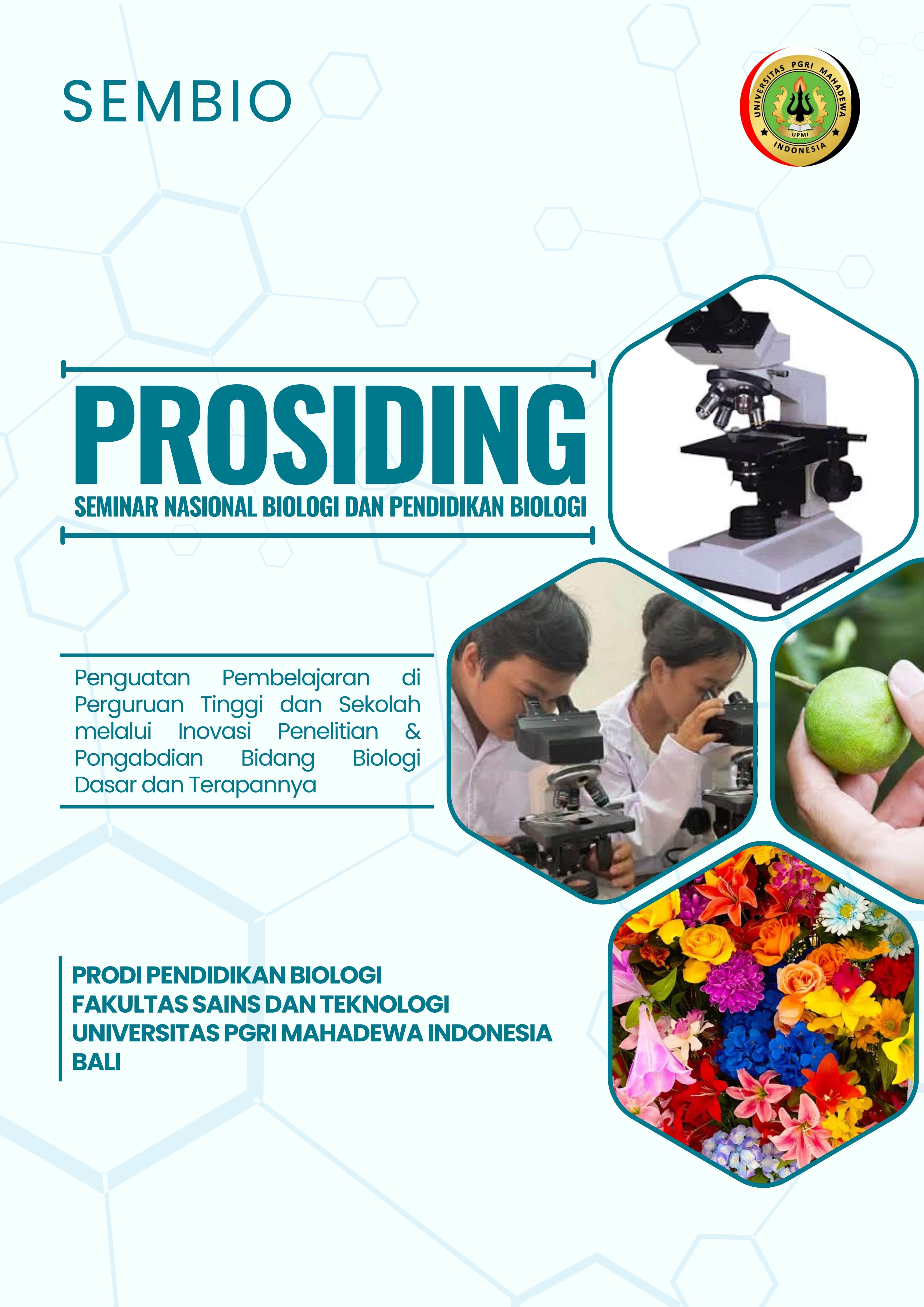PEMANFAATAN TANAMAN OBAT BERBASIS KEARIFAN LOKAL DALAM PEMBELAJARAN BIOLOGI KONTEKSTUAL DI SMA NEGERI 9 DENPASAR
DOI:
https://doi.org/10.59672/sembio.v3.4709Keywords:
Local wisdom, medicinal plants, contextual biology, environmental-based learning, SMA Negeri 9 DenpasarAbstract
Local wisdom is a learning resource rich in ecological, social, and cultural values that can be utilized in education, especially biology learning. In Bali, the use of medicinal plants by the community is not only for traditional medicine, but also part of the cultural heritage that reflects the harmonious relationship between humans and nature. This study aims to explore and integrate the potential of local medicinal plants as contextual learning resources in biology subjects at SMA Negeri 9 Denpasar. The method used is an exploratory qualitative study through observations of the school environment, interviews with community leaders and biology teachers, and documentation of local ethnobotany references. The results of the exploration showed that there are at least twelve species of medicinal plants commonly used by the local community, including temulawak (Curcuma xanthorrhiza), cat's whiskers (Orthosiphon aristatus), and pule pandak (Rauvolfia serpentina). These three plants have interesting morphological characteristics to study as well as pharmacological properties that are relevant to public health issues. The integration of these plants in biology learning is carried out through a contextual approach, such as herbarium creation projects, identification of plant structures, and creation of educational videos based on field studies. This activity increases student engagement in the learning process and strengthens the relationship between biological concepts and local realities around them. This finding emphasizes the importance of integrating local knowledge into the school curriculum as a strategy to enrich open materials, increase learning motivation, and foster awareness of conservation and preservation of local culture. This study recommends the development of systematic local wisdom-based teaching materials as a concrete step in supporting Independent Learning and preserving local identity through education.
Downloads
References
Des. M. 1993. Inventarisasi Tumbuhan Obat Tradisional di Kotamadya Padang. Abstr.2678. hal 38. Dalam Sari Laporan Penelitian dan Survei Jilid 18. 1995. Pusat Dokumentasi dan Informasi Ilmiah – LIPI, Jakarta.
Departemen Pendidikan Nasional. (2003). Kamus Besar Bahasa Indonesia. Jakarta: Balai Pustaka.
Departemen Pendidikan Nasional. (2006). Peraturan Menteri Pendidikan Nasional Nomor 22 Tahun 2006 tentang Standar Isi untuk Satuan Pendidikan Dasar dan Menengah. Jakarta: Depdiknas.
Dharma, A. 2001.Uji Bioaktifitas Metabolit Sekunder. Makalah Workshop Peningkatan Sumber Daya Alam Hayati dan Rekayasa Bioteknologi. FMIPA UNAND, Padang.
Hariyadi, S. 2001. Khasiat Tanaman TOGA untuk Pengobatan Alternatif. Penerbit Kalamedia, Jakarta.
H. Setiawan and M. Qiptiyah (2014). “Kajian Etnobotani Masyarakat Adat Suku Morone di Taman Nasional Rawa Aopa Watumohai,” Jurnal Penelitian Kehutanan Wallacea, vol. 3, no. 2, pp. 107–117.
Johnson, E. B. (2002). Contextual Teaching and Learning: What It Is and Why It’s Here to Stay. California: Corwin Press.
Kemendikbud. (2020). Kebijakan Merdeka Belajar: Panduan Pembelajaran Kontekstual. Jakarta: Direktorat Jenderal Guru dan Tenaga Kependidikan.
Moleong, L. J. (2019). Metodologi Penelitian Kualitatif (Edisi Revisi). Bandung: PT Remaja Rosdakarya.
Suryanegara, M., Wibowo, A., & Prasetyo, H. (2020). Pendidikan Berbasis Kearifan Lokal sebagai Penguatan Nilai Budaya dalam Kurikulum Sekolah. Jurnal Pendidikan dan Kebudayaan, 25(3), 217–229. https://doi.org/10.24832/jpnk.v25i3.357
Sutrisno, E. (2021). Integrasi Pengetahuan Lokal dalam Pembelajaran IPA: Suatu Upaya Pelestarian Budaya. Jurnal Pendidikan Sains, 9(2), 145–153.
Downloads
Published
How to Cite
Issue
Section
License
Copyright (c) 2025 SEMBIO: Prosiding Seminar Nasional Biologi dan Pendidikan Biologi

This work is licensed under a Creative Commons Attribution-ShareAlike 4.0 International License.
Authors who publish with the Jurnal Sewagti agree to the following terms:
1. Authors retain copyright and grant the journal the right of first publication with the work simultaneously licensed under a Creative Commons Attribution License (CC BY-SA 4.0) that allows others to share the work with an acknowledgment of the work's authorship and initial publication in this journal.
2. Authors are able to enter into separate, additional contractual arrangements for the non-exclusive distribution of the journal's published version of the work (e.g., post it to an institutional repository or publish it in a book), with an acknowledgment of its initial publication in this journal.
3. Authors are permitted and encouraged to post their work online (e.g., in institutional repositories or on their website) prior to and during the submission process, as it can lead to productive exchanges, as well as earlier and greater citation of published work. (See The Effect of Open Access) .









